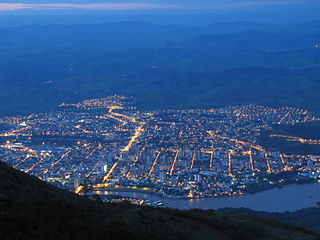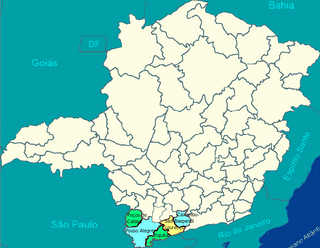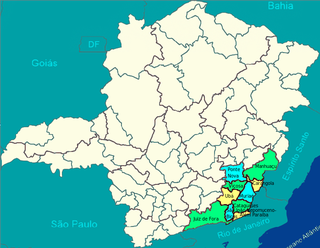
Governador Valadares is a Brazilian municipality in the countryside of Minas Gerais. In 2020, its population was 281,046 inhabitants, thus being the ninth most populated city in the state. It is an economical axis of the middle valley of the Doce River, having a significant influence on the east and northeast portion of Minas Gerais and local authorities of the state of Espírito Santo. Governador Valadares sits on the bank of the Doce River, 324 km from Belo Horizonte, the state's capital. Governador Valadares has an area of about 2 342 km2, being only 58 km2 of urban area.

The Intermediate Geographic Region of Pouso Alegre is one of the 13 intermediate geographic regions in the Brazilian state of Minas Gerais and one of the 134 of Brazil, created by the National Institute of Geography and Statistics (IBGE) in 2017.

The Intermediate Geographic Region of Varginha is one of the 13 intermediate geographic regions in the Brazilian state of Minas Gerais and one of the 134 of Brazil, created by the National Institute of Geography and Statistics (IBGE) in 2017.

The Intermediate Geographic Region of Juiz de Fora is one of the 13 intermediate geographic regions in the Brazilian state of Minas Gerais and one of the 134 of Brazil, created by the National Institute of Geography and Statistics (IBGE) in 2017.

The Intermediate Geographic Region of Ipatinga is one of the 13 intermediate geographic regions in the Brazilian state of Minas Gerais and one of the 134 of Brazil, created by the National Institute of Geography and Statistics (IBGE) in 2017.

The Intermediate Geographic Region of Montes Claros is one of the 13 intermediate geographic regions in the Brazilian state of Minas Gerais and one of the 134 of Brazil, created by the National Institute of Geography and Statistics (IBGE) in 2017.

The Intermediate Geographic Region of Belo Horizonte is one of the 13 intermediate geographic regions in the Brazilian state of Minas Gerais and one of the 134 of Brazil, created by the National Institute of Geography and Statistics (IBGE) in 2017.

The Intermediate Geographic Region of Divinópolis is one of the 13 intermediate geographic regions in the Brazilian state of Minas Gerais and one of the 134 of Brazil, created by the National Institute of Geography and Statistics (IBGE) in 2017.

The Intermediate Geographic Region of Patos de Minas is one of the 13 intermediate geographic regions in the Brazilian state of Minas Gerais and one of the 134 of Brazil, created by the National Institute of Geography and Statistics (IBGE) in 2017.

The Intermediate Geographic Region of Teófilo Otoni is one of the 13 intermediate geographic regions in the Brazilian state of Minas Gerais and one of the 134 of Brazil, created by the National Institute of Geography and Statistics (IBGE) in 2017.

The Immediate Geographic Region of Governador Valadares is one of the 4 immediate geographic regions in the Intermediate Geographic Region of Governador Valadares, one of the 70 immediate geographic regions in the Brazilian state of Minas Gerais and one of the 509 of Brazil, created by the National Institute of Geography and Statistics (IBGE) in 2017.

The Immediate Geographic Region of Guanhães is one of the 4 immediate geographic regions in the Intermediate Geographic Region of Governador Valadares, one of the 70 immediate geographic regions in the Brazilian state of Minas Gerais and one of the 509 of Brazil, created by the National Institute of Geography and Statistics (IBGE) in 2017.

The Immediate Geographic Region of Mantena is one of the 4 immediate geographic regions in the Intermediate Geographic Region of Governador Valadares, one of the 70 immediate geographic regions in the Brazilian state of Minas Gerais and one of the 509 of Brazil, created by the National Institute of Geography and Statistics (IBGE) in 2017.

The Immediate Geographic Region of Aimorés-Resplendor is one of the 4 immediate geographic regions in the Intermediate Geographic Region of Governador Valadares, one of the 70 immediate geographic regions in the Brazilian state of Minas Gerais and one of the 509 of Brazil, created by the National Institute of Geography and Statistics (IBGE) in 2017.

The Immediate Geographic Region of Frutal is one of the 4 immediate geographic regions in the Intermediate Geographic Region of Uberaba, one of the 70 immediate geographic regions in the Brazilian state of Minas Gerais and one of the 509 of Brazil, created by the National Institute of Geography and Statistics (IBGE) in 2017.

The Immediate Geographic Region of Abaeté is one of the 6 immediate geographic regions in the Intermediate Geographic Region of Divinópolis, one of the 70 immediate geographic regions in the Brazilian state of Minas Gerais and one of the 509 of Brazil, created by the National Institute of Geography and Statistics (IBGE) in 2017.

The Immediate Geographic Region of Formiga is one of the 6 immediate geographic regions in the Intermediate Geographic Region of Divinópolis, one of the 70 immediate geographic regions in the Brazilian state of Minas Gerais and one of the 509 of Brazil, created by the National Institute of Geography and Statistics (IBGE) in 2017.

The Immediate Geographic Region of Pedra Azul is one of the 7 immediate geographic regions in the Intermediate Geographic Region of Teófilo Otoni, one of the 70 immediate geographic regions in the Brazilian state of Minas Gerais and one of the 509 of Brazil, created by the National Institute of Geography and Statistics (IBGE) in 2017.

The Immediate Geographic Region of Capelinha is one of the 7 immediate geographic regions in the Intermediate Geographic Region of Teófilo Otoni, one of the 70 immediate geographic regions in the Brazilian state of Minas Gerais and one of the 509 of Brazil, created by the National Institute of Geography and Statistics (IBGE) in 2017.



















